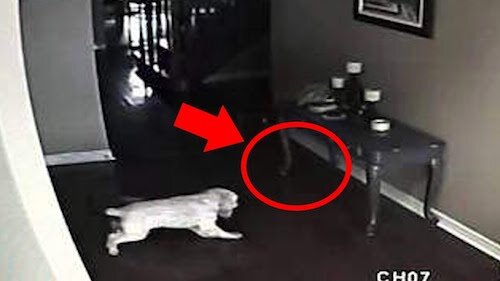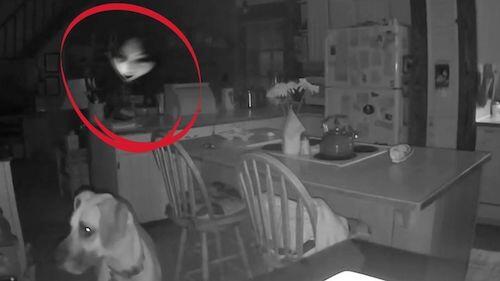
The Paranormal Theory: Can Dogs See Ghosts?
Introduction
The idea that dogs possess an innate ability to perceive the supernatural is a captivating notion that has persisted for centuries. Tales of dogs reacting to unseen presences or displaying unusual behavior in purportedly haunted locations are common in folklore and popular culture. This leads to an intriguing question: can dogs see ghosts?
Read More: Top 10 Dog Breeds With The Shortest Lifespans
To delve into this paranormal theory, it’s essential to explore a combination of historical anecdotes, scientific studies on canine senses, and psychological perspectives. By examining the evidence and theories, we aim to provide a comprehensive understanding of whether our four-legged companions might have the ability to sense the supernatural.
Historical Context and Cultural Beliefs
Throughout history, dogs have been associated with the supernatural in various cultures. In ancient Egypt, Anubis, the god of the afterlife, was often depicted with the head of a jackal, an animal closely related to dogs. Similarly, Greek mythology featured Cerberus, the multi-headed dog guarding the gates of the underworld. These mythological representations hint at a long-standing belief in dogs’ connection to the otherworldly.
In more recent history, ghost stories and folklore frequently include accounts of dogs reacting to ghosts. From Victorian England to contemporary America, tales of dogs barking at empty spaces, refusing to enter certain rooms, or exhibiting signs of fear without apparent cause are abundant. These stories contribute to the belief that dogs might have an enhanced ability to detect paranormal activity.
The Science of Canine Senses
To understand whether dogs can see ghosts, it’s crucial to examine their sensory capabilities. Dogs possess acute senses that surpass human abilities in many ways, potentially making them more attuned to phenomena we cannot perceive.
Vision
Dogs’ vision is fundamentally different from that of humans. While they have fewer color receptors, resulting in limited color perception, their eyes are more adapted to low-light conditions. Dogs can see in the dark better than humans and detect motion more effectively, which might explain why they sometimes appear to notice things that are invisible to us.
Hearing
A dog’s hearing is significantly more sensitive than a human’s. They can detect higher frequencies and hear sounds from much greater distances. This heightened auditory perception allows dogs to pick up on noises that humans cannot hear, such as the subtle creaks and groans of a house settling or the faint rustle of an unseen animal. Such acute hearing could be mistaken for sensitivity to paranormal activity.
Smell
Dogs are renowned for their extraordinary sense of smell. With up to 300 million olfactory receptors compared to humans’ 5 million, dogs can detect minute scent traces. This heightened sense of smell allows them to perceive changes in their environment that humans might miss, such as the presence of another person or animal, even if they are not visible.
Anecdotal Evidence and Case Studies
Anecdotal evidence forms a significant part of the argument for dogs’ ability to see ghosts. Numerous pet owners report instances of their dogs behaving strangely in the presence of what they believe to be supernatural entities. These reports often describe dogs barking at nothing, staring intently at a particular spot, or displaying signs of fear or agitation without any apparent cause.
Case Study 1: The Haunting of Borley Rectory
Borley Rectory, often cited as one of the most haunted houses in England, provides a notable case study. Numerous reports from visitors included accounts of dogs reacting to unseen presences. These reactions ranged from barking and growling to showing signs of extreme distress. While skeptics argue that these reactions could be due to the dogs sensing normal but subtle environmental cues, believers maintain that the dogs were reacting to ghosts.
Case Study 2: The Myrtles Plantation
The Myrtles Plantation in Louisiana is another location with a storied history of paranormal activity. Visitors have reported dogs refusing to enter certain rooms, barking at invisible entities, and displaying unusual behavior such as cowering or whining. These reactions have led many to believe that the dogs are sensing the presence of spirits.
Scientific Explanations and Skepticism
While the anecdotal evidence is compelling, the scientific community remains largely skeptical about the notion that dogs can see ghosts. Scientists argue that the behaviors interpreted as reactions to the supernatural can often be explained by natural phenomena or psychological factors.
Natural Explanations
Many behaviors attributed to ghost sightings can be explained by a dog’s keen senses. For example, a dog barking at an empty room could be reacting to sounds or smells that humans cannot perceive. Dogs’ ability to detect subtle changes in their environment means they might react to drafts, temperature fluctuations, or distant noises that are imperceptible to us.
Psychological Factors
Psychologists suggest that humans might project their beliefs and fears onto their pets. Known as confirmation bias, this occurs when people interpret ambiguous or unrelated dog behaviors as evidence of paranormal activity because it aligns with their existing beliefs. Additionally, dogs are highly attuned to their owners’ emotions and behaviors. If an owner is anxious or fearful in a supposedly haunted location, their dog might pick up on these cues and react accordingly.
Paranormal Research and Theories
Despite scientific skepticism, paranormal researchers continue to investigate the possibility that dogs can see ghosts. These researchers propose various theories to explain how dogs might perceive the supernatural.
Electromagnetic Fields (EMF) Theory
One popular theory in paranormal research is that ghosts or spirits emit electromagnetic fields (EMFs) that can be detected by sensitive individuals and animals. Some researchers believe that dogs, with their acute senses, might be able to perceive these EMFs, leading to their reported reactions to paranormal activity.
Quantum Physics and Multiverse Theory
Another theoretical framework comes from the realm of quantum physics. Some physicists propose that parallel universes or alternate dimensions could intersect with our own, occasionally allowing entities from these other realms to be perceived. If this is the case, dogs, with their heightened senses, might be more capable of detecting these anomalies than humans.
Energy and Vibration Theory
Some paranormal researchers believe that spirits exist as energy forms with specific vibrational frequencies. Dogs, being highly sensitive to vibrations and energy changes, might be able to detect these spiritual energies. This theory aligns with the idea that dogs can sense earthquakes and other natural phenomena through subtle vibrations.
Behavioral Analysis of Dogs in Paranormal Contexts
Understanding dog behavior in the context of paranormal activity involves careful observation and analysis. Researchers and pet owners often look for specific signs that might indicate a dog is reacting to an unseen presence.
Body Language
Dogs communicate primarily through body language. Signs that a dog might be sensing something unusual include:
- Staring intently at a particular spot for an extended period.
- Raised hackles, indicating heightened arousal or fear.
- Whining, barking, or growling at seemingly nothing.
- Tail tucking or cowering, suggesting fear or anxiety.
Environmental Sensitivity
Dogs might exhibit heightened sensitivity in environments with purported paranormal activity. Researchers and paranormal investigators often note that dogs’ reactions can serve as indicators for further investigation. For example, if a dog consistently reacts to a specific room or area, it might prompt investigators to use EMF detectors or other tools to search for evidence of paranormal activity.
Differentiating Between Paranormal and Natural Reactions
Differentiating between natural and potentially paranormal reactions requires careful consideration of the context and environment. Factors to consider include:
- Consistency of behavior: Does the dog react similarly in other locations, or is the behavior unique to the supposed haunted site?
- Environmental factors: Are there drafts, temperature changes, or sounds that could explain the dog’s behavior?
- Owner’s influence: Is the owner’s anxiety or belief in the paranormal influencing the dog’s reactions?
The Role of Training and Socialization
A dog’s training and socialization can significantly impact their behavior in unfamiliar environments. Well-socialized dogs are less likely to react fearfully to new stimuli, while poorly socialized dogs might display anxiety or aggression in similar situations. Training can also help dogs respond appropriately to their owner’s cues, reducing the likelihood of misinterpreting natural reactions as paranormal.
Training Techniques
Basic obedience training is crucial for helping dogs navigate various environments calmly. Commands such as “sit,” “stay,” and “come” can help manage a dog’s behavior and provide reassurance. Desensitization techniques, where dogs are gradually exposed to new stimuli, can also reduce anxiety and improve their ability to cope with unfamiliar situations.
Paranormal Investigations Involving Dogs
Some paranormal investigation teams include dogs as part of their investigative process. These dogs, often trained for search and rescue or detection work, can offer unique insights during investigations. Their reactions are documented alongside technological data to identify potential correlations between canine behavior and environmental anomalies.
Case Study: Paranormal Investigations with Canine Partners
Several paranormal investigation teams have reported intriguing results when including dogs in their investigations. For example, during an investigation at a historic mansion, a trained search and rescue dog consistently reacted to a particular room. Subsequent investigations revealed high EMF readings in that area, suggesting a potential correlation between the dog’s behavior and an environmental anomaly.
Psychological Perspectives on Dogs and the Paranormal
From a psychological perspective, the belief that dogs can see ghosts can be understood through the lens of human-animal bonding and the projection of human emotions onto pets.
Human-Animal Bonding
The strong emotional bond between humans and dogs can lead to the attribution of human-like qualities to pets. This anthropomorphism might cause owners to interpret their dog’s behavior in a way that aligns with their beliefs about the paranormal. The comfort and companionship provided by dogs can also reinforce these beliefs, as people look for validation of their experiences through their pets.
Projection of Emotions
People often project their emotions and fears onto their dogs. In stressful or frightening situations, such as being in a reportedly haunted location, an owner’s anxiety can influence their dog’s behavior. This can create a feedback loop, where the dog’s reaction reinforces the owner’s belief in paranormal activity, further increasing the owner’s anxiety.
Ethical Considerations and Welfare of Dogs in Paranormal Settings
When considering the possibility of dogs perceiving ghosts, it’s essential to address the ethical implications and welfare of the animals involved. Subjecting dogs to potentially stressful or frightening situations for the sake of paranormal investigation or curiosity can be ethically questionable.
Ensuring Well-being
The well-being of dogs should always be the priority. Owners and investigators must ensure that dogs are not placed in situations that could cause undue stress or harm. Monitoring the dog’s behavior and providing reassurance and comfort are crucial. If a dog shows signs of distress, it’s important to remove them from the situation and address their needs.
Ethical Guidelines
Paranormal investigation teams that include dogs should adhere to ethical guidelines that prioritize the animals’ welfare. This includes:
- Proper training: Ensuring dogs are well-trained and accustomed to the environments they will be investigating.
- Safety measures: Providing a safe and comfortable environment for the dogs during investigations.
- Monitoring and support: Continually monitoring the dogs for signs of stress and providing necessary support and intervention.
Conclusion
The question of whether dogs can see ghosts remains a fascinating and largely unanswered one. While there is ample anecdotal evidence suggesting that dogs react to unseen presences, scientific explanations often provide alternative interpretations based on dogs’ heightened senses and the influence of their owners’ emotions.
Ultimately, the belief in dogs’ ability to perceive the paranormal is deeply rooted in cultural history and human psychology. Whether or not dogs can see ghosts, the stories and experiences shared by dog owners worldwide contribute to the enduring mystery and allure of the paranormal.
As we continue to explore this intriguing topic, it’s essential to balance curiosity with the well-being and ethical treatment of our canine companions. Whether you’re a believer, a skeptic, or simply intrigued by the possibility, the bond between humans and dogs will undoubtedly continue to inspire tales of the supernatural for generations to come.

